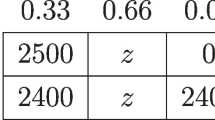Abstract
Experiments have identified a number of well-known violations of expected utility theory, giving rise to alternative models of choice under uncertainty, all of which are able to explain these violations. In this article, predictions of several prominent rival formulations are examined. No single alternative consistently organizes choices. Among the more important inconsistencies, we identify conditions generating systematic fanning in of indifference curves in the unit probability triangle, and find risk-loving over a number of gambles with all positive payoffs, in cases where prospect theory predicts risk aversion.
Similar content being viewed by others
References
BattalioRaymond C., John H.Kagel, and DonMcDonald. (1985). “Animals' Choices Over Uncertain Outcomes: Some Initial Experimental Results,” American Economic Review 75, 597–613.
BeckerGordon M., Morris H.DeGroot, and JacobMarschak. (1964). “Measuring Utility by a Single-Response Sequential Method,” Behavioral Science 9, 226–232.
CamererColin. (1989). “An Experimental Test of Several Generalized Utility Theories,” Journal of Risk and Uncertainty 2, 61–104.
Chew, Soo Hong, and Larry G. Epstein. (1987). “A Unifying Approach to Axiomatic Non-Expected Utility Theories,” John Hopkins University Department of Political Economy working paper.
Chew, Soo Hong, and Kenneth L. MacCrimmon. (1979). “Alpha-Nu Choice Theory: A Generalization of Expected Utility Theory,” University of British Columbia Faculty of Commerce and Business Administration Working Paper No. 669, mimeographed.
ChewSoo Hong, and William S.Waller. (1986). “An Empirical Test of Weighted Utility Theory Using the HILO Structure,” Journal of Mathematical Psychology 30, 55–72.
ChewSoo Hong, AdiKarni, and ZviSafra. (1987). “Risk Aversion in the Theory of Expected Utility with Rank Dependent Probabilities,” Journal of Economic Theory 42, 370–381.
Grether, David. (1981). “Financial Incentive Effects and Individual Decision Making,” Social Science Working Paper no. 401, Pasadena, California Institute of Technology.
GretherDavid, and CharlesPlott. (1979). “Economic Theory of Choice and the Preference Reversal Phenomena,” American Economic Review 69, 623–638.
Harless, David W. (1987). “Predictions About Indifference Curves in the Unit Probability Triangle: A Test of Some Competing Decision Theories,” Mimeograph. Indiana University.
HersheyJohn, and PaulSchoemaker. (1980). “Prospect Theory's Reflection Effect Hypothesis: A Critical Examination,” Organizational Behavior and Human Performance 25, 395–418.
HoltCharles. (1986). “Preference Reversals and the Independence Axiom,” American Economic Review 76, 508–515.
Kagel, John H., Don MacDonald, and Raymond C. Battalio. (1989). “Tests of ‘Fanning Out’ of Indifference Curves for Random Prospects: Results from Animal and Human Experiments,” Mimeograph, University of Pittsburgh.
KahnemanDaniel, and AmosTversky. (1979). “Prospect Theory: An Analysis of Decision Under Risk,” Econometrica 47, 263–291.
KarniEdi, and ZviSafra. (1987). “‘Preference Reversal’ and the Observability of Preferences by Experimental Methods,” Econometrica 55, 675–685.
LoomesGraham. (1982). “Testing for Regret and Disappointment in Choice Under Uncertainty,” Economic Journal, 97 118–129.
LoomesGraham. (1988a). “Further Evidence of the Impact of Regret and Disappointment in Choice Under Uncertainty,” Economica 55, 47–62.
LoomesGraham. (1988b). “When Actions Speak Louder Then Prospects,” American Economic Review 78, 463–470.
LoomesGraham, and RobertSugden. (1982). “Regret Theory: An Alternative Theory of Rational Choice Under Uncertainty,” Economic Journal 92, 805–824.
LuceR. Duncan, and LouisNarens. (1985). “Classification of Concatenation Measurement Structures According to Scale Type,” Journal of Mathematical Psychology 29, 1–72.
MacDonald, Don, John H. Kagel, and Raymond C. Battalio. (1989). “Animals' Choices Over Uncertain Outcomes: Further Experimental Results,” Mimeograph, University of Pittsburgh.
MachinaMark J. (1982). “‘Expected Utility’ Analysis Without the Independence Axiom,” Econometrica 50, 277–324.
MachinaMark J. (1983a). “Generalized Expected Utility Analysis and the Nature of Observed Violations of the Independence Axiom.” In B.Stigum and F.Wenstop (eds.), Foundations of Utility and Risk Theory with Applications. Dordrecht: D. Reidel
Machina, Mark J. (1983b). “The Economic Theory of Individual Behavior Toward Risk: Theory, Evidence and New Directions,” IMSSS Technical Report no. 433, Stanford University.
MacCrimmonKenneth R., and StigLarsson. (1979). “Utility Theory: Axioms Versus “Paradoxes'.” In MauriceAllais and OleHagen (eds.), Expected Utility Hypotheses and the Allais Paradox. Dordrecht: D. Reidel.
SchoemakerPaul. (1982). “The Expected Utility Model: Its Variants, Purposes, Evidence and Limitations,” Journal of Economic Literature 20, 529–563.
SegalUje. (1987). “Some Remarks on Quiggan's Anticipated Utility,” Journal of Economic Behavior and Organization 8, 145–154.
SlovicPaul, and SarahLichtenstein. (1968). “The Relative Importance of Probabilities and Payoffs in Risk Taking,” Journal of Experimental Psychology 78, 1–18.
SugdenRobert. (1986). “New Developments in the Theory of Choice Under Uncertainty,” Bulletin of Economic Research 38, 1–24.
Starmer, C., and Robert Sugden. (1987a). “Experimental Evidence of the Impact of Regret on Choice Under Uncertainty,” Economics Research Centre discussion paper no. 23, University of East Anglia.
Starmer, C., and Robert Sugden. (1987b). “Violations of the Independence Axiom: An Experimental Test of Some Competing Hypotheses,” Economics Research Centre discussion paper no. 24, University of East Anglia.
Thaler, Richard H., and Eric J. Johnson. (In press). “The Effect of Prior Outcomes on Risky Choice,” Management Science.
TverskyAmos, and DanielKahneman. (1986). “Rational Choice and the Framing of Decisions,” Journal of Business 59, S251-S278.
WeberMartin, and ColinCamerer. (1987). “Recent Developments in Modeling Risk Under Uncertainty,” OR Spectrum 9, 129–151.
YaariMenahem. (1987). “The Dual Theory of Choice Under Risk,” Econometrica 55, 95–115.
Author information
Authors and Affiliations
Rights and permissions
About this article
Cite this article
Battalio, R.C., Kagel, J.H. & Jiranyakul, K. Testing between alternative models of choice under uncertainty: Some initial results. J Risk Uncertainty 3, 25–50 (1990). https://doi.org/10.1007/BF00213259
Issue Date:
DOI: https://doi.org/10.1007/BF00213259




